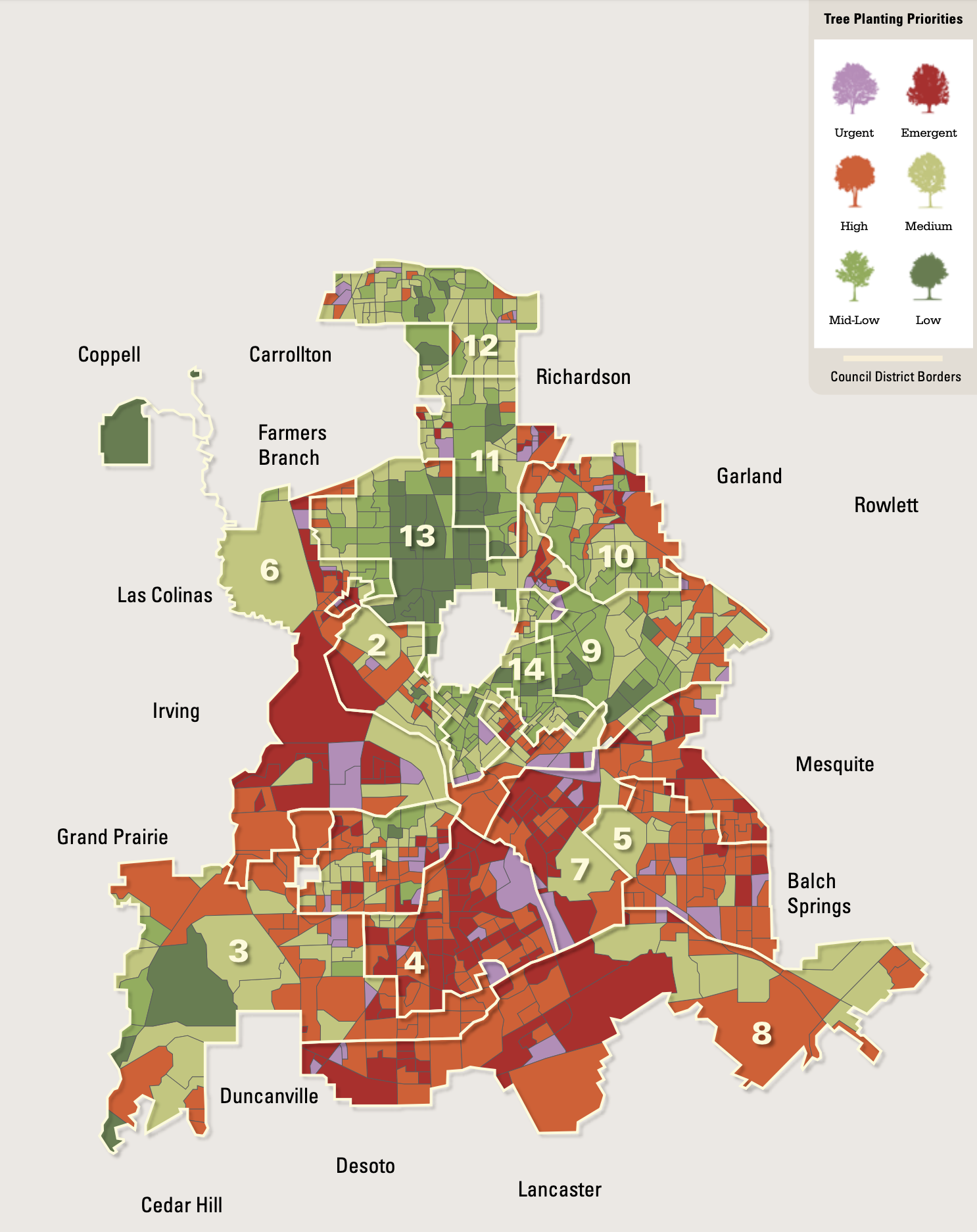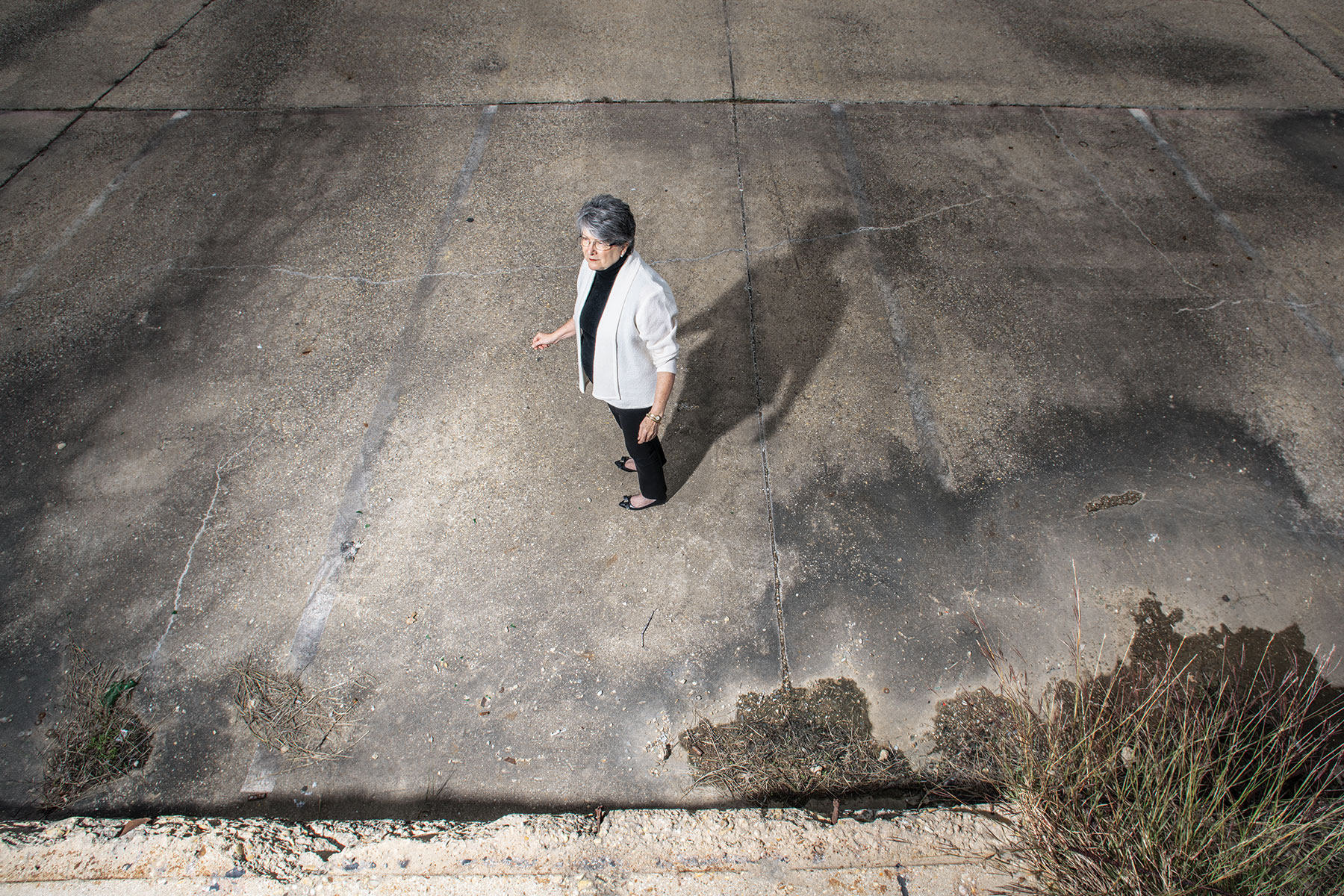Dallas-Fort Worth International Airport recorded a temperature of 107 degrees on Tuesday, which is the hottest it’s been on August 1 in a dozen years. The nonprofit Climate Central, a consortium of researchers and scientists, says the real temperature is at least another 8 degrees higher.
The Dallas-Fort Worth-Arlington metro area is one of the nation’s worst examples of what those researchers call “sprawling heat intensity,” the condition caused by miles upon miles of concrete that makes us hotter than the National Weather Service says we are, no matter where we are. Some cities see a more concentrated “urban heat island” effect in certain neighborhoods, but 75 percent of DFW residents are feeling an average of 7.7 bonus degrees. Sidewalks and roads suck in heat and then slowly emit it; Climate Central says these surfaces can be as hot as 150 degrees.
Dallas isn’t alone. About 41 million Americans live inside a Census tract that is 8 degrees or higher than the present temperature, according to the analysis. That amounts to about 55 percent of the U.S. population studied in the report. Climate Central analyzed about 19,000 of those tracts in 44 American cities to find where urban heat is most concentrated, using a model created from a different study in 2020 that assigned numeric values based on the types of land covering and population density.
Only Los Angeles, Houston, and New York have more people living with higher temperatures than DFW.
Locally, no other organization has been raising awareness of the urban heat island effect like the Texas Trees Foundation. The nonprofit was started in 1982 as a booster for Dallas parks, but gradually extended its purview into city right of way. It has spent years growing more ambitious, launching important, first-ever studies that sought to help Dallas better understand the importance of a robust tree canopy.
In 2015, the nonprofit released its first State of the Dallas Urban Forest report, which catalogued 14.7 million trees over Dallas’ 340 square miles. (If you had to replace them all, it would cost $9.02 billion—the first time anyone put a monetary value on our tree canopy.) In 2021, the foundation delivered an Urban Forest Master Plan to the city. It identified how the city could meet its climate goals of increasing the tree canopy from 32 percent to 37 percent, and applied an equity analysis to determine the parts of town that needed the new trees most.
Then this summer hit. This year will probably be the hottest summer since 2011, when Dallas recorded 40-straight days of triple digit temperatures. This week alone has delivered five straight days of excessive heat warnings, making Dallas one of the country’s hottest cities. It has been 19 days since North Texas had measurable rainfall, according to the National Weather Service.
“These temperatures—it’s a moral issue now,” said Janette Monear, the president and CEO of Texas Trees.
The Texas Trees team offices in the concrete-flanked Pegasus Park tower off Interstate 35E. The organization has 14 monitors collecting radiant heat data from the sun-soaked parking lot. Those monitors have recorded surface temperatures of up to 140 degrees. As shown in the Climate Central report, that level of heat is hardly unique to the nonprofit’s headquarters.
Texas Trees also has about a dozen monitors on the roof of Parkland Hospital, where the nonprofit is overseeing an ambitious plan to redesign and reconstruct the Medical District. Recommendations include shrinking Harry Hines, adding another nine miles of sidewalks to the current total of 12 miles, and improving access between the medical buildings spread across Inwood Road. They also involve improving green infrastructure, such as adding another 6,500 trees along walking paths and a central park that Texas Trees calls the “Green Spine.” Construction is expected to begin on the first phase next year.
Monear views the excessive heat as a “moral issue” because, to her and the people who work with her, those numbers have physical consequences. There are affected people on the other end of the temperature readings. She notes that we tend to downplay the heat—it’s summer in Texas; of course it’s hot—but that downplays the impact our decisions have. Texas Trees is trying to get us to understand that “extreme heat is a major public health problem, particularly in urban areas.”
“People are being admitted to the hospital with third-degree burns,” Monear said of hospitals around Phoenix, citing anecdotes from physician executives.
Rose Jones worked for Texas Trees for about a year and a half. Her hiring was another sign that the organization’s mission is broader than its name implies. Jones has a doctorate in medical anthropology, has been a faculty member of UT Southwestern, and taught at Parkland. She took the job with Texas Trees because she understands how heat affects people, and not everyone else does. Not even physicians, she said, who don’t typically include heat-related questions in pre-screening of patients.
“We have no screening, and we have limited surveillance,” she said. “And it’s a complicated health condition, right? Because you can be a pre-term labor, low birth weight, all of these things. We know they’re connected to heat, but we’re not teaching it. We’re not capturing the data. And now we’ve got 68 people lying in Parkland trying to get admitted.”
That number was in reference to a single day in July, which had been shared with the Texas Trees team by a physician executive. Parkland spokeswoman April Foran reported treating 114 people with heat-related complaints from June 2 to July 21.
In talking with other doctors, Jones fears that number is higher at hospitals across Dallas-Fort Worth. In recent years, major scientific journals have begun to publish studies that show how heat can be a factor in a slew of major health conditions.
“There is really good data to suggest a relationship between ambient high temperatures and mental health conditions. We also know there is a correlation between low birth weight, premature labor, cardiovascular disease, and respiratory disease,” she said. “It affects the entire body.”
A study published last month in The Lancet found that “heat exposure is an important but underappreciated risk factor contributing to cardiovascular disease.”
“The widespread prevalence of exposure to hot temperatures, in conjunction with an increase in the proportion of older people in the population, might result in a rise in poor cardiovascular disease health outcomes associated with a warming climate,” it reads.
A 2022 study in JAMA Psychiatry of more than 2 million patients, from 2010 to 2019, found emergency room visits for mental health conditions were more common during periods of extreme heat.
“These temperatures—it’s a moral issue now.”
Janette Monear, CEO of the Texas Trees Foundation
“This finding may be informative for clinicians providing mental health services during periods of extreme heat to prepare for increases in health service needs when times of extreme heat are anticipated,” it reads.
NPR recently highlighted a study from Boston that observed young adults who were living in dorms, some of which did not have air conditioning, during a heat wave. The students took tests. One of the researchers said the results showed “reductions in the order of 10 percent in their response times and also their accuracy.”
The heat is hitting all of us in different ways, but especially our most vulnerable. Texas Trees’ latest study is the Dallas Tree Equity Planting Map. The map breaks down the tree canopy in each City Council district into priority blocks in identify the specific areas that need tree coverage the most. The map highlights public land and rights of way in which planting could be suitable and no existing trees are present. Despite southern Dallas having more than a third of the city’s tree coverage, most of the need is concentrated below Interstate 30.

The nonprofit notes that trees can help cool urban areas up to 15 degrees by providing shade to impervious surfaces, and it cites data that show heat-related deaths are reduced by 20 percent when trees are planted in the hottest areas with high residential density. But it is also emphasizes the fact that trees alone won’t save us. Architects will need to design their projects to address urban heat, and the city and its partners will need to rethink where utilities are placed and how buildings are permitted.
Jones noted the irony, while discussing the JAMA Psychiatry study that showed higher incidences of mental health emergencies during days of extreme heat, of a current Medical District construction project. The state of Texas is building the city’s first state behavioral health facility at the corner of Medical District Drive and Harry Hines: a glass-walled rectangle that will reflect the sun back to the street.
“They just built the state’s site in the middle of an urban heat island, one of the worst urban heat islands in the country,” Jones said. “It’s a total disconnect.”
Through her work with the organization, Jones realized that our healthcare systems and other major institutions must incorporate heat in their planning. She resigned from Texas Trees last week to become a consultant who helps academics and physicians, among others, better understand the connection between heat and health. She said she “felt morally compelled to move in this direction,” citing, as an example, how state lawmakers are refusing to mandate prisons become air conditioned. This issue is bigger than trees, after all.
All of this is why Texas Trees wants us to bake heat into our decision-making wherever possible. This summer has made it clear that these temperatures are here to stay. What we do with that reality is up to us.
Author






